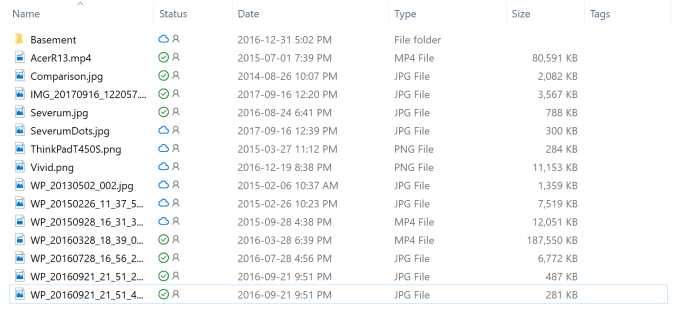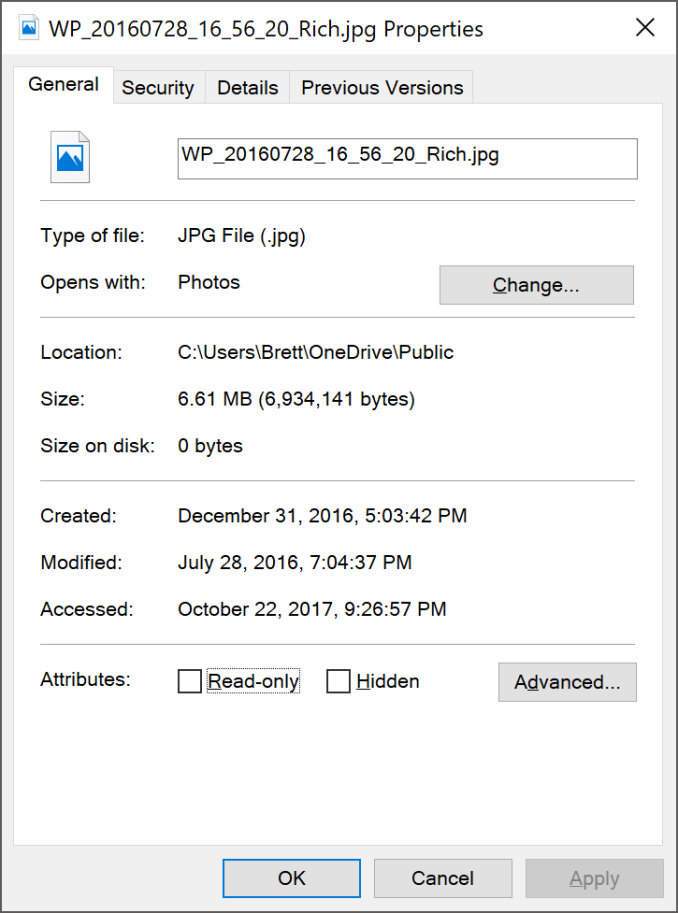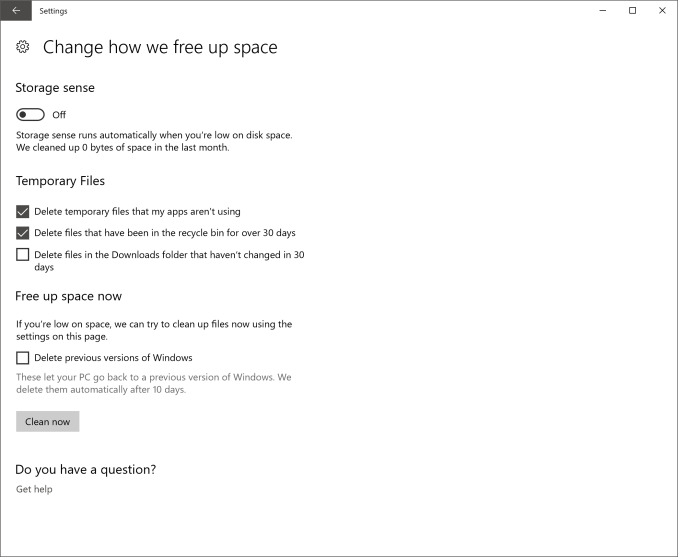The Windows 10 Fall Creators Update Feature Focus
by Brett Howse on November 10, 2017 8:00 AM ESTOneDrive Files on Demand
I’ll admit, I’m a heavy user of OneDrive. It was a tough pill to swallow when Windows 10 launched and removed the support for OneDrive placeholders that arrived with Windows 8.1. Placeholders allowed you to see your entire OneDrive collection, even if it wasn’t downloaded to your PC, and then if you needed a file, you could double click it to download and open. It’s a simple concept, but the original implementation had some issues. Some of the issues were end-user related, such as people not understanding a file they had access to at home might not be available to them on an airplane, and some of them were app issues with the extended delays that might occur when waiting to download a file.
With the new Files on Demand, hopefully that is all fixed. First off, there’s a new setting in the OneDrive app in the system tray that enables and disables this functionality.
If you really prefer to just have everything downloaded, you can keep the original Windows 10 method where only folders you explicitly say to sync are downloaded. If you want Files on Demand, you have to check the box.
Once checked, files in OneDrive will gain a new status icon to display if they are online or downloaded. As I quickly found out though, it’s a bit confusing, in that OneDrive will still only display folders that you have told it to display in the Select Folders settings. So even if you have 10,000 files in your music folder, you won’t see them unless you first ensure that folder is synced. The difference is now it won’t download the file until you access it.
If you open a file, Windows 10 will automatically download it for you, and then open it. Depending on the size of the file, and your network speed, this could cause some delay, but the space savings will be significant, especially if you have a smaller SSD.
Microsoft has created a settings page for Automatic File Downloads, where you can unblock apps from automatically downloading files. For reasons that don’t seem to make any sense, this setting is under the Privacy section of Settings, and it doesn’t appear to be fleshed out yet, since you can’t block apps here, only unblock them. The wording does make it seem like Microsoft is going to open this up to other online file providers as well, which should be good news for many.
Also, in what is almost certainly a bid to improve performance, if you open a photo, for instance, and it has to be downloaded first, Windows 10 will also automatically download the photo before and after, so that if you move to the next file, it’s already available. This is a good idea for performance, but you may end up downloading lots of files you didn’t need.
Overall, first impressions of Files on Demand is positive. It can be a bit confusing to set up, since unlike Windows 8.1, you have to still tell it which folders you want to see, but the performance is solid, and it is very easy to distinguish between files that are already downloaded and those that are not. You still get a thumbnail for images that aren’t downloaded as well.
Storage Sense
In addition to freeing up space by being able to access your OneDrive files only when you need them, Microsoft has improved Storage Sense in an effort to automatically help clean up files you likely no longer require.
One of the most useful ones, at least for me, will be to delete files in Downloads that haven’t changed in 30 days. That folder tends to accumulate a lot of cruft that doesn’t need to be kept.
In addition, it can automatically empty your recycle bin, temp files, and previous versions of Windows, which are kept for a period of time in case you need to or want to roll back to the last version.
Storage Sense is a small idea, but should be very helpful. It even keeps track of how much space it’s cleaned up for you.
One obvious improvement here would be to integrate this with OneDrive as well, to give the option to clean up space from OneDrive files you haven’t accessed in a while now that Files on Demand can fetch them back quickly. Hopefully this comes in a future update.














95 Comments
View All Comments
ddrіver - Sunday, November 12, 2017 - link
Oh, and don't get me started on the whole "other big OS makers collect everything about you at all times" or "other big OS makers don't bother to push hardware vendors to support phone hardware more than 2-3 years so you only get 1 or 2 years of major updates". M$ is the real problem here.BurntMyBacon - Wednesday, November 15, 2017 - link
@ddriver: "Oh, and don't get me started on the whole "other big OS makers collect everything about you at all times" or "other big OS makers don't bother to push hardware vendors to support phone hardware more than 2-3 years so you only get 1 or 2 years of major updates"."You want me to brush aside grievances from other vendors to make Microsoft look worse by lack of comparison? I REFUSE!!! Phones and tablets may be consumption devices that you are better off leaving anything sensitive far away from, but they've been pushed as computer replacements, they've been developed for as computer replacements, and much of the market uses them as computer replacements. People email on their phones, send sensitive messages on their phones, use their phones to facilitate payments, and even bank on their phones. You can either call out people for doing things the are not educated enough to know they shouldn't do on their phones, or you can call out the vendors for creating and environment designed to cater to these practices while siphoning data in the background. Not everyone can be a security expert and the average consumer has a difficult enough time with malicious entities sending bad emails, texts, and links through their messenger/social app of choice. They shouldn't have to consider companies like Google, Microsoft, and Apple as malicious entities.
@ddriver: "M$ is the real problem here."
No. If Microsoft fixed everything, it would not affect the issues you stated above with other vendors. Microsoft's actions are problematic for sure and they should not be excused just because vendor X, Y, and Z are worse. However, Microsoft's actions are a symptom of a larger problem created by the anti-privacy features built into iOS and Android devices when smartphones were rising in popularity and perpetuated by the lack of concern over these privacy invading features by the worldwide market. If enough people wholesale dropped these platforms (read: Significant loss of profits) for a less invasive platform despite the extra costs and inconveniences involved, then they would fix some of these problems. Unfortunately, not enough people seem to care.
cwolf78 - Friday, November 10, 2017 - link
Funny how there are a ton of comparison benchmarks including on this very site that completely refute your anecdotal claims.Mo3tasm - Friday, November 10, 2017 - link
You can benchmark how you want, but the "perceived" difference can't be benchmarked.mr_tawan - Saturday, November 11, 2017 - link
perception sometime is truth, some other time is illusion."Bullwinkle J Moose" - Friday, November 10, 2017 - link
"slower than Win7 or even Win8.1"----------------------------------------------
That depends.....
Bootup and shutdown speed is markedly faster but doing anything with your data is markedly slower
"Bullwinkle J Moose" - Friday, November 10, 2017 - link
I just again tested Windows 8.1 boot time at 14 seconds (that is normal)Win 10 Full Crapper Edition booted to the same PC with the same SSD in 5.3 seconds
ddriver - Friday, November 10, 2017 - link
Who cares about boot up speed, I boot up once every few months. Even a regular user doesn't boot up nowhere nearly enough to make a difference, when it craps over your entire usage."Bullwinkle J Moose" - Friday, November 10, 2017 - link
Regular users, sure, but I measure it and care because I have been known to boot several different operating systems from this machine in a single dayBIOS is set so that there is no primary boot device, which means that I can swap drives (or thumb drives) while the computer is rebooting and it will boot to whatever is currently plugged in instead of fumbling in the BIOS to change the boot order
Makes testing something new quick and easy, whether its in XP, Linux, Win 7, Win 8 or any Edition of Spyware Platform 10
"Bullwinkle J Moose" - Friday, November 10, 2017 - link
I also keep all the bootable SSD's on an external SATA to ESATA+USB Power cable so when I switch from SSD to thumb drive during a reboot, all I need to do is unplug the USB power to the SSD boot drive and plug in a thumb drive during reboot